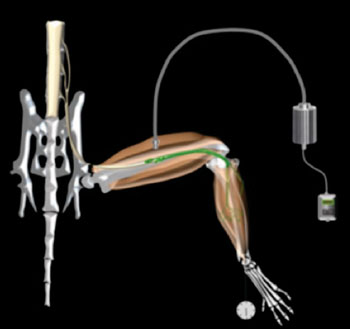Light-Activated Neurons Restore Function to Paralyzed Muscles
By LabMedica International staff writers
Posted on 15 Apr 2014
A new approach has been developed to synthetically control muscles using light, with the hope of restoring function to muscles paralyzed by disorders such as spinal cord injury and motor neuron disease.Posted on 15 Apr 2014
The technique involves transplanting specially-designed motor neurons created from stem cells into damaged nerve branches. These motor neurons are devised to react to pulses of blue light, allowing researches to customize muscle control by adjusting the duration, intensity, and frequency of the light pulses.

Image: Diagram showing how the system works (Photo courtesy of Barney Bryson, UCL).
In the study published April 2014 in Science, scientists from University College London (UCL; UK) and King’s College London (UK) demonstrated the technology in lab mice in which the nerves that supply muscles in the hind legs were injured. They showed that the transplanted stem cell-derived motor neurons grew along the injured nerves to connect effectively with the paralyzed muscles, which could then be controlled by pulses of blue light.
“Following the new procedure, we saw previously paralyzed leg muscles start to function,” noted Prof. Linda Greensmith of the MRC Center for Neuromuscular Diseases at UCL’s Institute of Neurology, who co-led the study. “This strategy has significant advantages over existing techniques that use electricity to stimulate nerves, which can be painful and often results in rapid muscle fatigue. Moreover, if the existing motor neurons are lost due to injury or disease, electrical stimulation of nerves is rendered useless as these too are lost.”
Muscles are typically controlled by motor neurons, which are specialized nerve cells within the brain and spinal cord. These neurons relay signals from the brain to muscles to initiate motor functions such as walking, standing and even breathing. However, motor neurons can become damaged in motor neuron disease or following spinal cord injuries, causing permanent loss of muscle function resulting in paralysis.
“This new technique represents a means to restore the function of specific muscles following paralyzing neurological injuries or disease,” clarified Prof. Greensmith. “Within the next five years or so, we hope to undertake the steps that are necessary to take this ground-breaking approach into human trials, potentially to develop treatments for patients with motor neuron disease, many of whom eventually lose the ability to breathe, as their diaphragm muscles gradually become paralyzed. We eventually hope to use our method to create a sort of optical pacemaker for the diaphragm to keep these patients breathing.”
The light-responsive motor neurons that made the technique possible were created from stem cells by Dr. Ivo Lieberam of the MRC Center for Developmental Neurobiology, King’s College London. “We custom-tailored embryonic stem cells so that motor neurons derived from them can function as part of the muscle pacemaker device,” said Dr. Lieberam, who co-led the study. “First, we equipped the cells with a molecular light sensor. This enables us to control motor neurons with blue light flashes. We then built a survival gene into them, which helps the stem-cell motor neurons to stay alive when they are transplanted inside the injured nerve and allows them to grow to connect to muscle.”
Related Links:
University College London
King’s College London













